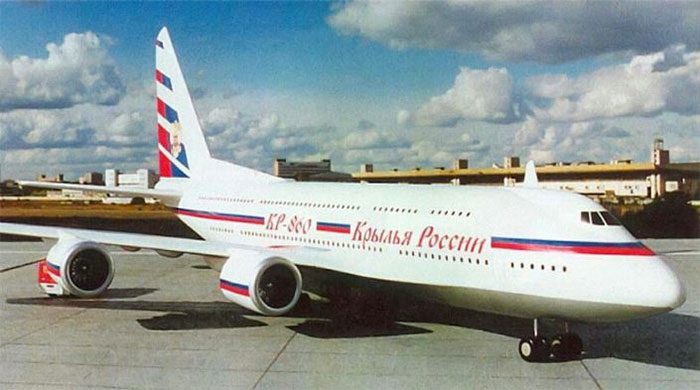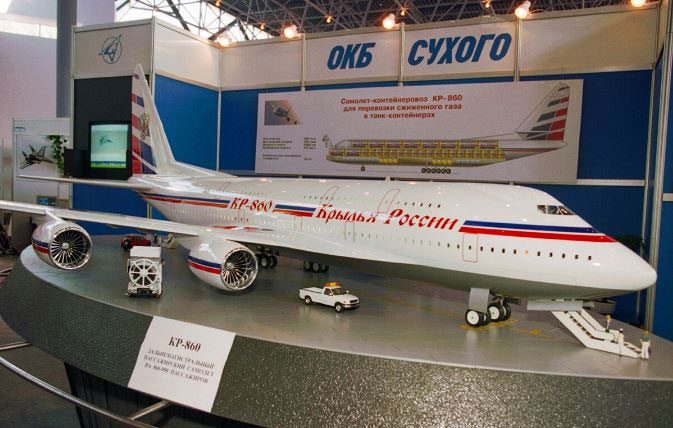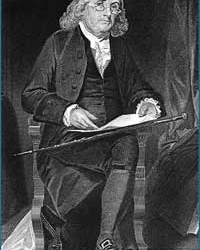In the 1990s, Russia was on the verge of owning the world’s largest passenger aircraft named KR-860 “Wings of Russia”.
This colossal machine was conceived by the Sukhoi Design Bureau. At that time, Sukhoi aimed to produce an aircraft that would bring economic benefits to the civil aviation sector. According to the company’s calculations, passenger traffic was expected to increase by 9-12% each year in the 21st century. Thus, the market would require a type of double-decker aircraft to transport a large number of passengers simultaneously.

Model of the KR-860 aircraft. Photo: Sukhoi Design Bureau.
“Corporations around the world were eyeing such a double-decker aircraft. The Americans created the Boeing 747, and the Europeans developed the massive Airbus A380. By the late 1990s, Sukhoi followed the general trend and did not want to miss out on the new double-decker segment for passenger transport,” said Alexei Vlasov, an aviation safety expert.
Russia showcased a 1/24 scale model of this aircraft at the Paris Air Show in 1999. If constructed, the KR-860 would have been the largest, widest, and heaviest passenger aircraft in the world.
Impressive Specifications
In the 1990s, the Russian aviation industry was undergoing a tough period, and companies needed a successful project to elevate the sector to new heights. Double-decker aircraft were the main trend globally at that time.
It was estimated that the project to manufacture the world’s largest civil aircraft, the KR-860, would cost up to $10 billion, with the goal of producing the first unit before the year 2000. Each aircraft was priced between $160 million and $200 million.
The design engineers planned to have 12 seats in the lower deck and 9 seats in the upper deck. Each KR-860 was expected to carry up to 860 passengers or a total weight of up to 650 tons. The wingspan of this “iron bird” would reach 88 meters, necessitating larger runways and hangars. Therefore, the designers decided to make the wings foldable, reducing the length to 64 meters.
This 80-meter-long aircraft could reach speeds of approximately 1,000 km/h and have a flight range of up to 15,000 km. There was also a proposed KR-860T version intended to be used as an airborne liquefied natural gas (LNG) carrier for Arctic regions.
Every detail was perfect on paper, but ultimately, why did Sukhoi abandon this project?
The Forgotten Project
The reason the KR-860 faded into obscurity is quite simple: economic crisis.
To create such an aircraft, the company would need to establish a completely new massive production chain to manufacture engines, airframes, dedicated facilities, and a host of other equipment. This capability did not exist in Russia during those years. According to expert Vlasov, a project like this required an investment of billions of dollars, and at that time, Sukhoi could not afford it.
He stated that Sukhoi could not initiate production of this aircraft because they initially did not receive government subsidies to fully develop it. This was the primary reason they abandoned the world’s largest civil aircraft project.

Model of the KR-860 aircraft. (Photo: TASS)
Although Sukhoi did not manufacture a specific double-decker aircraft, foreign competitors have released several models to the market, including the Airbus A380 and Boeing 747.
According to him, the maintenance costs for the Airbus A380 and Boeing 747 are quite high. They also require significant time for technical preparations before each flight.
“It takes two and a half hours to prepare each aircraft for takeoff. You need to disembark the old passengers and luggage, refuel, check the liquids, load new luggage, and board new passengers. All of this takes a considerable amount of time. In comparison, similar procedures for a 200-passenger aircraft take about 40 minutes. Simply put, producing smaller aircraft is more economically viable,” the expert emphasized.
Currently, airlines are phasing out similar products to the KR-860, such as the Airbus A380 and Boeing 747. The first Airbus produced in Europe two decades ago has been scrapped. Meanwhile, Boeing 747s are being converted into cargo aircraft for military use.
Alexei Vlasov believes that Russia did not miss any opportunities and even benefited from the decision not to produce the KR-860 double-decker aircraft. There were no investment costs, while the technological know-how was retained.
This expert concluded: “We produced technical documentation for next-generation aircraft engines that were later used in the production of Sukhoi military aircraft and the civil SSJ-100.”





















































